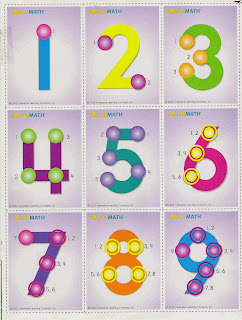The website can describe their program better then I ever can but I did want to highlight what I like from the program.
I have used this program for teaching one-to-one correspondence for students who really struggle with identifying the number with the quantity. For instance they may be able to count out 3 blocks with out difficulty and but when it comes to then picking out the number 3 there is a break down. I often give these students a 3 to 4 inch size number and asked them to put pom poms, stickers, etc on the touch points. I typically start by having dots already there so they know where to place them and then I fade them out.
The above image shows the different touchpoint numbers. It gets a bit tricky once you get past 6. I stray from the double touch points if I am simply teaching one to one correspondence. Instead of using double circles with numbers past 6, I often have students just put the correct number of dots on the number. The touchmath company does have nice tactile numbers that can be ordered, they have textured numbers with glittery and rough dots.
Touchmath is especially handy when you start teaching addition and subtraction skills to struggling students. They simply have to memorize the dots and then add them. Ideally the students should identify the largest number and start from there so when adding 5 + 3, the student would say "5, 6, 7, 8". For some students who are at the very basic level of math, they may need to just count all of the dots for addition.
Touchmoney is a program by touchmath that I think is overlooked far too often. The program assigns dots to all forms of money and requires students to add money by counting by 5s
So in the above image you would count up the coins by counting by 5s, except of course for the penny. For struggling students, this helps with money skills a lot.

No comments:
Post a Comment